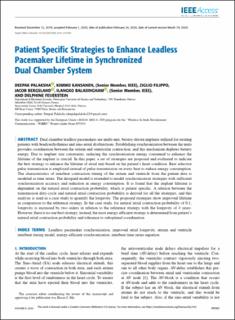| dc.contributor.author | Palaksha, Deepak | |
| dc.contributor.author | Kansanen, Kimmo | |
| dc.contributor.author | Filippo, Ziglio | |
| dc.contributor.author | Bergsland, Jacob | |
| dc.contributor.author | Balasingham, Ilangko | |
| dc.contributor.author | Feuerstein, Delphine | |
| dc.date.accessioned | 2022-05-03T12:48:03Z | |
| dc.date.available | 2022-05-03T12:48:03Z | |
| dc.date.created | 2020-11-27T17:01:08Z | |
| dc.date.issued | 2020 | |
| dc.identifier.citation | IEEE Access. 2020, 8 49363-49376. | en_US |
| dc.identifier.issn | 2169-3536 | |
| dc.identifier.uri | https://hdl.handle.net/11250/2993958 | |
| dc.description.abstract | Dual chamber leadless pacemakers are multi-unit, battery-driven implants utilized for treating patients with bradyarrhythmias and sino-atrial dysfunctions. Establishing synchronization between the units provides coordination between the atrium and ventricular contraction, and this mechanism depletes battery energy. Due to implant size constraints, reducing the synchronization energy consumed to enhance the lifetime of the implant is crucial. In this paper, a set of strategies are proposed and evaluated to indicate the best strategy to enhance the lifetime of atrial unit based on the patient's heart condition. Beat selective pulse transmission is employed instead of pulse tr 4?0ansmission on every beat to reduce energy consumption. The characteristics of interbeat contraction timing of the atrium and ventricle from the patient data is modeled as time series. The designed model is extended to model synchronization strategies with sufficient synchronization accuracy and reduction in energy consumption. It is found that the implant lifetime is dependent on the natural atrial contraction probability, which is patient specific. A relation between the transmission duty-cycle and natural atrial contraction probability is derived for all the strategies, and this analysis is used in a case study to quantify the longevity. The proposed strategies show improved lifetime in comparison to the reference strategy. In the case study, for natural atrial contraction probability of 0.1, longevity is increased by two orders in relation to the reference strategy with the longevity of 4 years. However, there is no one best strategy; instead, the most energy-efficient strategy is determined from patient's natural atrial contraction probability and tolerance to suboptimal coordination. | en_US |
| dc.language.iso | eng | en_US |
| dc.publisher | Institute of Electrical and Electronics Engineers (IEEE) | en_US |
| dc.rights | Navngivelse 4.0 Internasjonal | * |
| dc.rights.uri | http://creativecommons.org/licenses/by/4.0/deed.no | * |
| dc.title | Patient specific strategies to enhance leadless pacemaker lifetime in synchronized dual chamber system | en_US |
| dc.title.alternative | Patient specific strategies to enhance leadless pacemaker lifetime in synchronized dual chamber system | en_US |
| dc.type | Peer reviewed | en_US |
| dc.type | Journal article | en_US |
| dc.description.version | publishedVersion | en_US |
| dc.source.pagenumber | 49363-49376 | en_US |
| dc.source.volume | 8 | en_US |
| dc.source.journal | IEEE Access | en_US |
| dc.identifier.doi | 10.1109/ACCESS.2020.2976010 | |
| dc.identifier.cristin | 1853520 | |
| cristin.ispublished | true | |
| cristin.fulltext | original | |
| cristin.qualitycode | 1 | |

